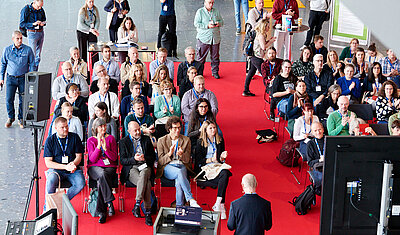The Arena 2025
Medical technology, digital product passports and UX writing were the main topics at this year's tcworld conference arena from November 11 to 13. The 20- to 30-minute short presentations by experts were very well attended – proof of how much these topics are currently moving the tech community. Afterwards, many attendees took the opportunity to ask individual questions or talk directly with the speakers.
Highlights from the arena sessions
Medical technology (November 11)
One particularly memorable contribution was "Potpourri of Medical Technology" by Marcelo Lackner (lyfmedics). In his presentation, he outlined a historical overview of how medical devices have become increasingly regulated over time and then shed light on the internal structures of a medical technology company – with a particular focus on the role of technical editors.
Lackner, himself a trained medical technician and regulatory expert, pointed out that editors are increasingly involved in safety- and risk-related processes: "Anyone working in a medical device company cannot ignore compliance and regulatory requirements," was a key aspect of his presentation.
Digital product passport (November 12)
Another presentation that attracted a lot of attention was “Digital Product Passport: How Can Companies Master the Challenges Ahead?” by Adrian Barwasser (Fraunhofer IAO). He explained how new EU regulations – including the digital product passport, the Machinery Regulation, and the digital type plate – are technically and regulatorily interrelated and what concrete effects they will have on manufacturing companies. Barwasser provided an overview of the legal environment surrounding the DPP – both at EU and national level – and encouraged technical editors to play a proactive role in the transformation. He also highlighted the activities and projects currently underway in research and industry, and the challenges and opportunities that the DPP introduction will bring in the future.
In addition, a fishbowl discussion on the topic of "The economic contribution to technical communication" with Lars Kothes (kothes GmbH), Anne Kuhsen (SEW-Eurodrive), Bernhard Rudolf (CHIRON Werke GmbH & Co. KG), and Bernd Waterkamp (BWeitblick Consulting) dominated the Wednesday afternoon in the arena. The aim of the roundtable was to discuss amongst experts and the audience what measurable value good technical communication actually creates for enterprises – and how this value can be made even more visible in the future.
A lively discussion ensued between the invited experts and participants who actively contributed to the discussion. They presented different perspectives on how technical communication can contribute to a company's value creation – from the practical implementation of digital processes in industry to new digital strategies for corporate communications. It became clear that technical communication is much more than just a necessary cost factor: it can reduce support costs, increase customer satisfaction, and thus contribute directly to value creation.
A concise conclusion aptly summed up the discussion: "The best documentation is the kind you don't see – because it's already firmly embedded in the machine." This formulated a forward-looking idea: when information is seamlessly integrated into products, systems, and processes, technical communication becomes invisible but all the more effective. It becomes an integral part of the user experience – and thus a real value driver for companies.
UX writing (November 13)
On Thursday, the arena finally turned its attention to UX writing. In her presentation on neuro-inclusive UX writing, Daria Lewandowska showed how microtexts can support digital participation. In addition, Stephan Mayer emphasized how crucial precise language is in clinical practice, while Arun Benny Haymo presented a model that systematically integrates technical editors into UI/UX validation processes (user interface/user experience validation processes).
In parallel, the World Usability Day Stuttgart took place, which focused on "Emerging Technologies and Human Experience" and ideally complemented the arena content. The contributions on AI, new UX methods, and human-centered technology design broadened the technical perspective and provided a natural connection between the two events in terms of content.
Overall, it was clear that the arena offered a mix of current trends, in-depth practical knowledge, and strategic perspectives. The lively participation of the audience and the intensive networking on site once again confirmed the central role that technical communication, and in particular the integration with UX plays in an increasingly complex technological world.
By this, the arena was not only well positioned in terms of topics, but also provided real impetus for the future of technical communication: medical technology, digital product passports, and UX writing—all three topics reflect the current transformation dynamics in the industry.
Text: Monika Vortisch Images: Roman Hermann; Monika Vortisch (Fishbowl)


